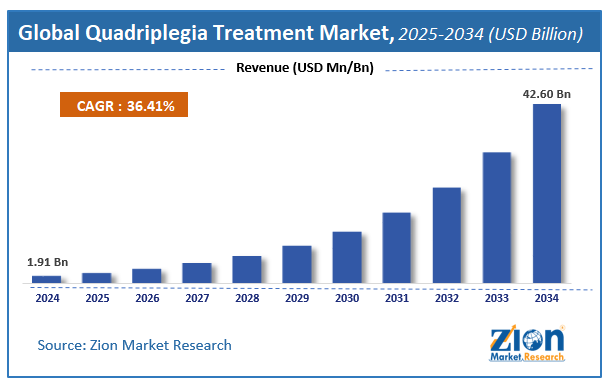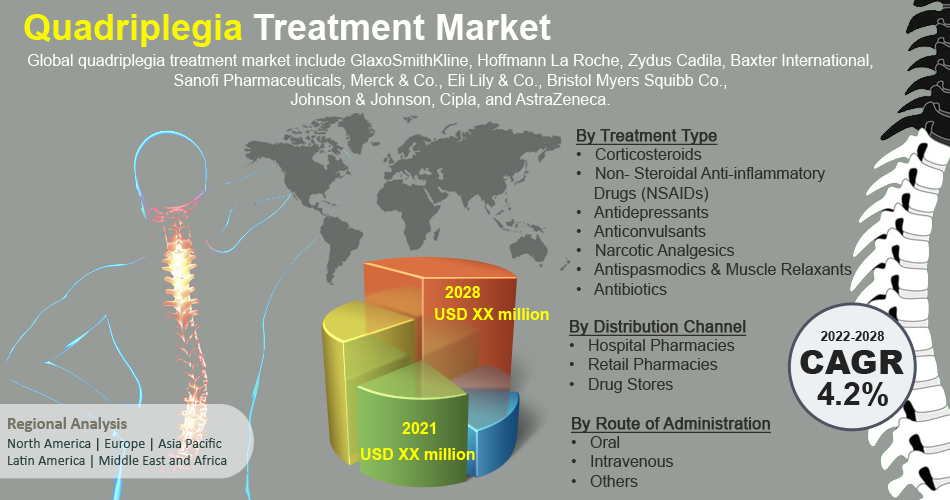Global Quadriplegia Treatment Market Size, Share, Growth Analysis Report - Forecast 2034

Quadriplegia Treatment Market By Treatment Type (Corticosteroids, Non-Steroidal Anti-inflammatory Drugs (NSAIDs), Antidepressants, Anticonvulsants, Narcotic Analgesics, Antispasmodics & Muscle Relaxants, Antibiotics), By Route of Administration (Oral, Intravenous, Others), Distribution Channel (Hospital Pharmacies, Retail Pharmacies, Drug Stores, Online Stores), Devices (Assistive Devices), and By Region: Global and Regional Industry Overview, Market Intelligence, Comprehensive Analysis, Historical Data, and Forecasts 2025 - 2034
| Market Size in 2024 | Market Forecast in 2034 | CAGR (in %) | Base Year |
|---|---|---|---|
| USD 1.91 Billion | USD 42.60 Billion | 36.41% | 2024 |
Quadriplegia Treatment Market: Industry Perspective
The global quadriplegia treatment market size was worth around USD 1.91 Billion in 2024 and is predicted to grow to around USD 42.60 Billion by 2034 with a compound annual growth rate (CAGR) of roughly 36.41% between 2025 and 2034.
The report analyzes the global quadriplegia treatment market's drivers, restraints/challenges, and the effect they have on the demands during the projection period. In addition, the report explores emerging opportunities in the quadriplegia treatment industry.
Quadriplegia Treatment Market: Overview
Quadriplegia is a disorder in which both legs & arms become paralyzed and lose their ability to move normally. This condition, sometimes known as tetraplegia, is a symptom of a few multiple different underlying causes. Quadriplegia comes in a variety of forms, one with its particular set of symptoms and effects on the body. Quadriplegia can be transitory (meaning muscular control recovers) or permanent (meaning the paralysis does not lessen) based on the underlying reason. Quadriplegia treatment methods differ depending on what is generating the weakening in the first place.
Key Insights
- As per the analysis shared by our research analyst, the global quadriplegia treatment market is estimated to grow annually at a CAGR of around 36.41% over the forecast period (2025-2034).
- Regarding revenue, the global quadriplegia treatment market size was valued at around USD 1.91 Billion in 2024 and is projected to reach USD 42.60 Billion by 2034.
- The quadriplegia treatment market is projected to grow at a significant rate due to advancements in regenerative medicine, increasing spinal cord injury cases, supportive healthcare infrastructure, and growing R&D in neurological therapies.
- Based on Treatment Type, the Corticosteroids segment is expected to lead the global market.
- On the basis of Route of Administration, the Oral segment is growing at a high rate and will continue to dominate the global market.
- Based on the Distribution Channel, the Hospital Pharmacies segment is projected to swipe the largest market share.
- By Devices, the Assistive Devices segment is expected to dominate the global market.
- Based on region, North America is predicted to dominate the global market during the forecast period.
Global Quadriplegia Treatment Market: Growth Drivers
The growing prevalence of spinal cord injury propels the market growth
Quadriplegia is caused by damage to the spinal cord that occurs as a result of trauma to the base of the skull or the neck. Quadriplegia is caused by a variety of factors including paralysis following spinal tumors, accidents, and other spinal disorders. A spinal cord injury can result in half or complete limb paralysis. It is been reported that every year, approximately 250,000 -500,000 people worldwide have a spinal cord injury. The majority of these occurrences are the result of avoidable factors such as car accidents and violence. Annually, around 17,000 instances of spinal cord injury are reported in the United States, with an estimated 282,000 people living with the condition. Such a huge burden of disease is estimated to boost the demand for quadriplegia treatment, thereby driving the market growth. In addition to this, high spending power and heavy investment in the development of healthcare infrastructure are also estimated to fuel the market growth.
Quadriplegia Treatment Market: Restraints
High costs associated with the treatment hinder the market growth
The least frequent kind of spinal cord damage, complete quadriplegia, is also the most severe. Quadriplegia can have tremendous long-term costs. In general, it varies based on the patient's age. The cost of total quadriplegia during the first year itself is estimated to be $1,064,716. Quadriplegia costs approximately $184,891 each year for the rest of the patient's life. A catastrophic injury case, on the other hand, might ask for much more, because these statistics don't account for the patient's mental anguish, suffering & pain, decreased earning ability, and lost income. Thus, such a high cost of quadriplegia treatment may hamper the growth of the market.
Quadriplegia Treatment Market: Opportunities
Technological advancements in the medical field are likely to spur the market growth
Technical advances and a range of R&D activities in the domain of quadriplegia therapy will be two of the major drivers driving the global quadriplegia treatment market in the coming years. Patients with spinal injuries have become more aware of the many therapeutic options available to assist them in overcoming their challenges. Further, major players are investing heavily in drug discovery and development for innovative & effective treatment. All these factors collectively are predicted to create numerous opportunities for the growth of the market during the forecast period.
Quadriplegia Treatment Market: Challenges.
Strict regulatory bodies pose a challenge to market growth
A strong regulatory framework in different countries for the approval and marketing of the drugs used for quadriplegia treatment may pose a major challenge to market expansion. The FDA has a strict regulatory structure that must be adhered to by all market players. With defined regulatory requirements, most new businesses encounter safety, quality, and effectiveness challenges. As a result, regulatory bodies are the most significant impediment to newcomers entering the quadriplegia treatment market.
Quadriplegia Treatment Market: Segmentation Analysis
The global quadriplegia treatment market is segmented based on Treatment Type, Route of Administration, Distribution Channel, Devices, and region.
Based on Treatment Type, the global quadriplegia treatment market is divided into Corticosteroids, Non-Steroidal Anti-inflammatory Drugs (NSAIDs), Antidepressants, Anticonvulsants, Narcotic Analgesics, Antispasmodics & Muscle Relaxants, Antibiotics.
On the basis of Route of Administration, the global quadriplegia treatment market is bifurcated into Oral, Intravenous, Others.
By Distribution Channel, the global quadriplegia treatment market is split into Hospital Pharmacies, Retail Pharmacies, Drug Stores, Online Stores.
In terms of Devices, the global quadriplegia treatment market is categorized into Assistive Devices.
Quadriplegia Treatment Market: Report Scope
| Report Attributes | Report Details |
|---|---|
| Report Name | Quadriplegia Treatment Market |
| Market Size in 2024 | USD 1.91 Billion |
| Market Forecast in 2034 | USD 42.60 Billion |
| Growth Rate | CAGR of 36.41% |
| Number of Pages | 207 |
| Key Companies Covered | Curemark, Bristol Myers Squibb, Tetraphase Pharmaceuticals, Neurotech, Medtronic, Reviva Pharmaceuticals, Thermo Fisher Scientific, Elekta, Amedisys, Life Spine, Zynex Medical, Parker Hannifin, Stryker, and others. |
| Segments Covered | By Treatment Type, By Route of Administration, By Distribution Channel, By Devices, and By Region |
| Regions Covered | North America, Europe, Asia Pacific (APAC), Latin America, The Middle East and Africa (MEA) |
| Base Year | 2024 |
| Historical Year | 2020 to 2023 |
| Forecast Year | 2025 - 2034 |
| Customization Scope | Avail customized purchase options to meet your exact research needs. Request For Customization |
Recent Developments
- In August 2021, Roche introduced an oral therapy for adults and children with Spinal Muscular Atrophy (SMA) (SMA). It's called Evrysdi, and it's the first and only medication for SMA patients in India.
- In August 2021, Mitsubishi Tanabe Pharma Development America, Inc. (MTDA) received a Fast Track Designation for MT-3921 for the treatment of spinal cord injury from the FDA.
Quadriplegia Treatment Market: Regional Landscape
North America dominates the market for quadriplegia treatment
Among the regions, North America is estimated to dominate the global quadriplegia treatment market and is expected to retain its dominance during the forecast period. The US is predicted to hold the largest market share owing to advanced technologies and growing awareness regarding different treatment options for quadriplegia. Europe is projected to hold the second-most position in the market owing to major research institutes. Asia Pacific is projected to be the most lucrative market during the forecast period and is anticipated to grow at the highest CAGR value.
Quadriplegia Treatment Market: Competitive Analysis
The report provides a company market share analysis to give a broader overview of the key market players. In addition, the report also covers key strategic developments of the market, including acquisitions & mergers, new product launches, agreements, partnerships, collaborations & joint ventures, research & development, and regional expansion of major participants involved in the quadriplegia treatment market on a global and regional basis.
The global quadriplegia treatment market is dominated by players like:
- Curemark
- Bristol Myers Squibb
- Tetraphase Pharmaceuticals
- Neurotech
- Medtronic
- Reviva Pharmaceuticals
- Thermo Fisher Scientific
- Elekta
- Amedisys
- Life Spine
- Zynex Medical
- Parker Hannifin
- Stryker
The global quadriplegia treatment market is segmented as follows;
By Treatment Type
- Corticosteroids
- Non-Steroidal Anti-inflammatory Drugs (NSAIDs)
- Antidepressants
- Anticonvulsants
- Narcotic Analgesics
- Antispasmodics & Muscle Relaxants
- Antibiotics
By Route of Administration
- Oral
- Intravenous
- Others
By Distribution Channel
- Hospital Pharmacies
- Retail Pharmacies
- Drug Stores
- Online Stores
By Devices
- Assistive Devices
By Region
- North America
- The U.S.
- Canada
- Mexico
- Europe
- France
- The UK
- Spain
- Germany
- Italy
- Rest of Europe
- Asia Pacific
- China
- Japan
- India
- Australia
- South Korea
- Rest of Asia Pacific
- The Middle East & Africa
- Saudi Arabia
- UAE
- Egypt
- Kuwait
- South Africa
- Rest of the Middle East & Africa
- Latin America
- Brazil
- Argentina
- Rest of Latin America
Table Of Content
Methodology
FrequentlyAsked Questions
The global quadriplegia treatment market is expected to grow due to advancements in neurorehabilitation, assistive technologies, and increasing incidence of spinal cord injuries.
According to a study, the global quadriplegia treatment market size was worth around USD 1.91 Billion in 2024 and is expected to reach USD 42.60 Billion by 2034.
The global quadriplegia treatment market is expected to grow at a CAGR of 36.41% during the forecast period.
North America is expected to dominate the quadriplegia treatment market over the forecast period.
Leading players in the global quadriplegia treatment market include Curemark, Bristol Myers Squibb, Tetraphase Pharmaceuticals, Neurotech, Medtronic, Reviva Pharmaceuticals, Thermo Fisher Scientific, Elekta, Amedisys, Life Spine, Zynex Medical, Parker Hannifin, Stryker, among others.
The report explores crucial aspects of the quadriplegia treatment market, including a detailed discussion of existing growth factors and restraints, while also examining future growth opportunities and challenges that impact the market.
RelatedNews
HappyClients
Zion Market Research
Tel: +1 (302) 444-0166
USA/Canada Toll Free No.+1 (855) 465-4651
3rd Floor,
Mrunal Paradise, Opp Maharaja Hotel,
Pimple Gurav, Pune 411061,
Maharashtra, India
Phone No +91 7768 006 007, +91 7768 006 008
US OFFICE NO +1 (302) 444-0166
US/CAN TOLL FREE +1 (855) 465-4651
Email: sales@zionmarketresearch.com
We have secured system to process your transaction.
Our support available to help you 24 hours a day, five days a week.
Monday - Friday: 9AM - 6PM
Saturday - Sunday: Closed







